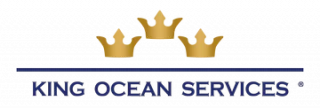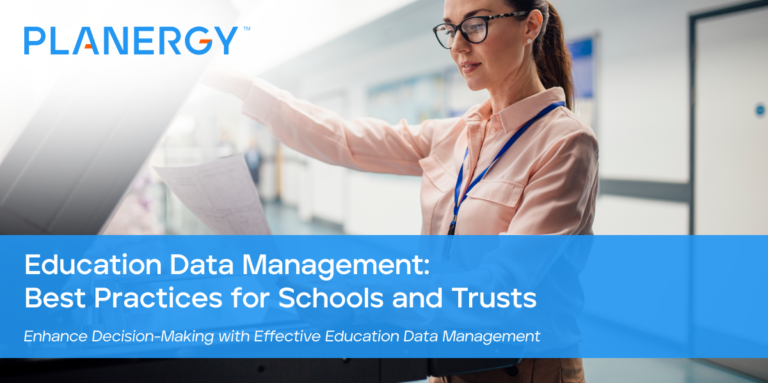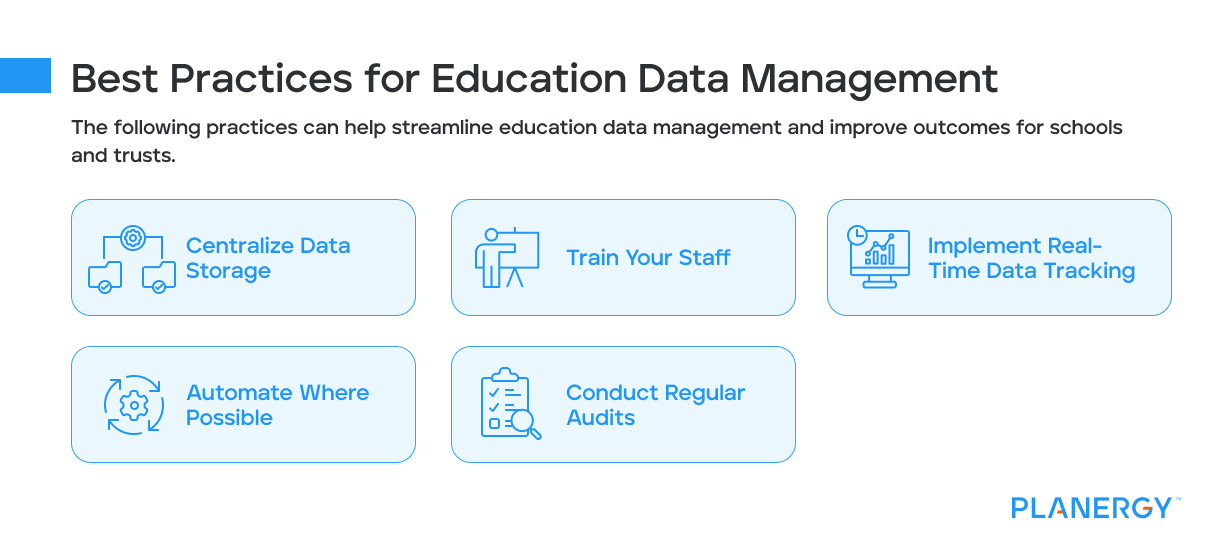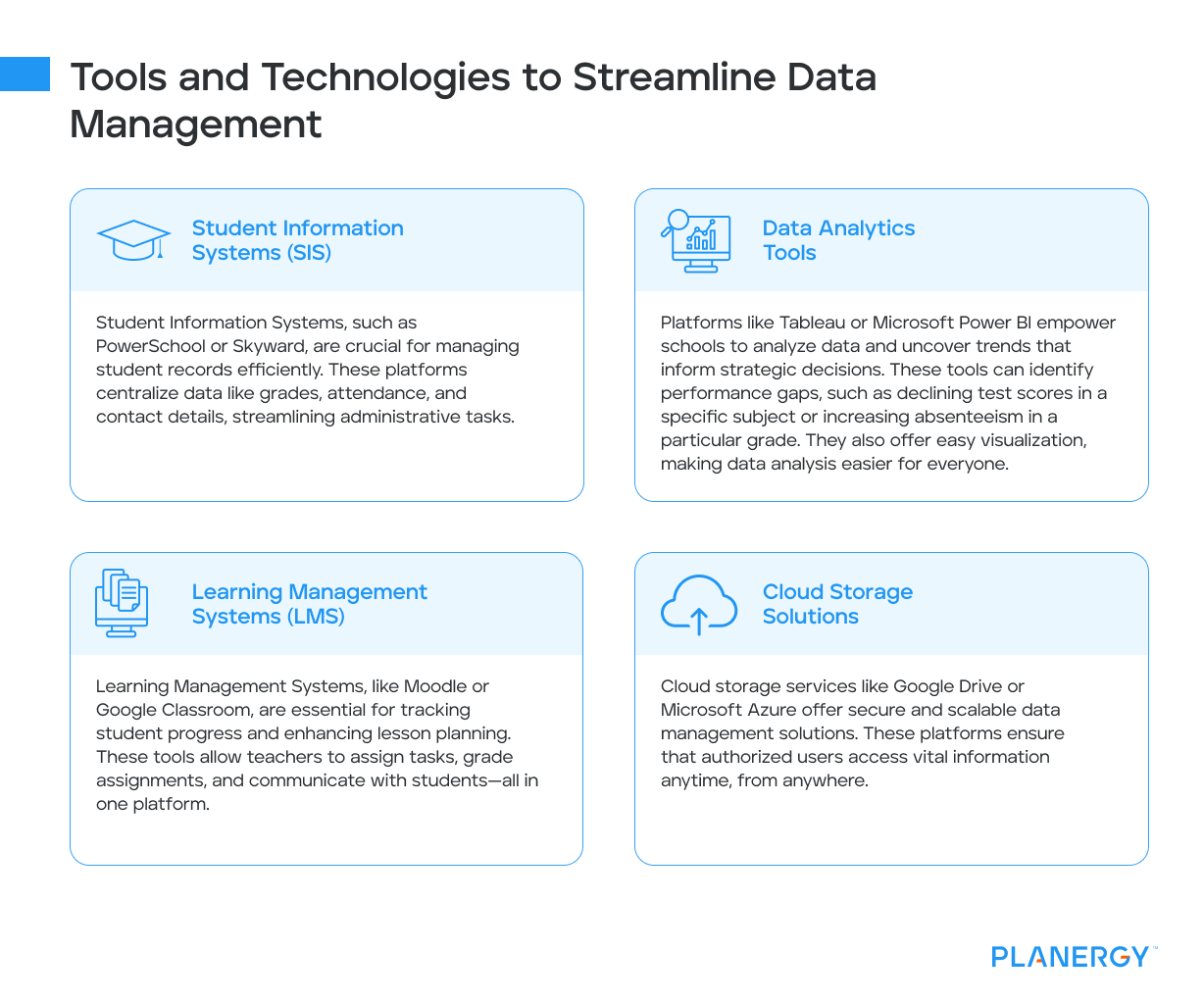Managing data effectively is at the heart of every successful educational organization.
From student achievement records and administrative details to resource management and compliance-related information, schools and trusts have a ton of data to handle.
Without the right systems and practices, this information can quickly become overwhelming or compromise operational efficiency.
The Importance of Data Management in Education
Data management helps schools and trusts track student progress, make informed decisions, allocate resources more effectively, and stay compliant with educational standards.
When done correctly, it ensures that data is accurate, accessible, and secure—empowering administrators and educators with the insights needed to make data-driven decisions for improvement and success.
Benefits of Effective Data Collection and Management
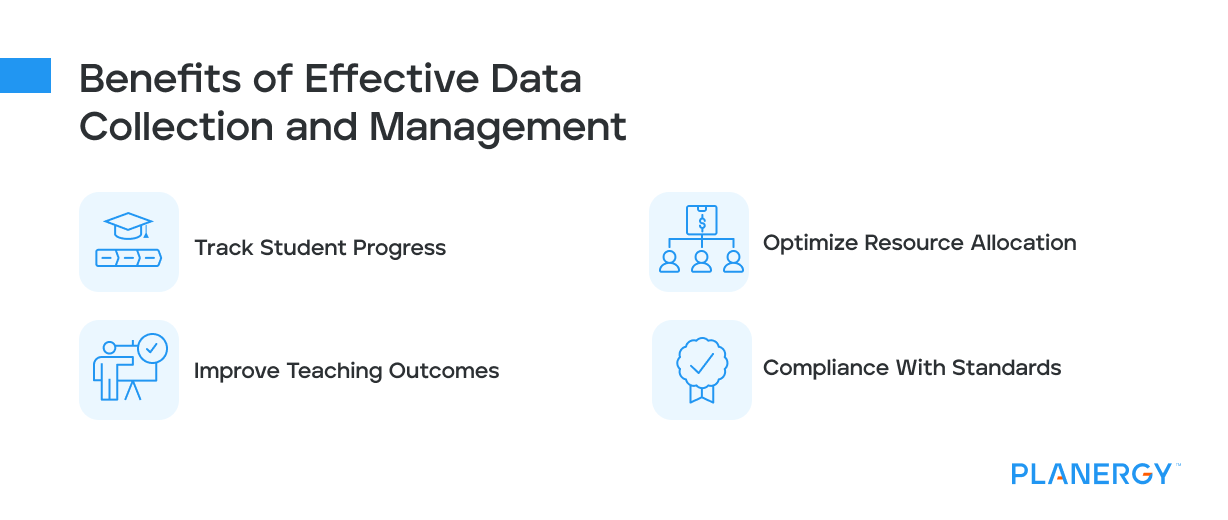
Track Student Progress
By leveraging data management systems, educators can identify trends in student performance over time.
For instance, a teacher might spot patterns such as declining math scores in a particular grade or increased absenteeism in a specific group.
With this information, proactive interventions can be implemented, such as targeted tutoring sessions or parent-teacher meetings, to address these challenges before they escalate.
Tracking tools allow for personalized learning experiences.
For example, an advanced student excelling in science could access more challenging materials, while another who struggles could receive additional support.
When schools focus on individual progress rather than generic benchmarks, every student has a better chance to thrive.
Optimize Resource Allocation
Resource allocation can make or break a school’s ability to meet its goals.
Education data management systems take the guesswork out of this process by providing actionable insights about where resources should be directed, which is especially helpful with GAG pooling.
Budget planning also becomes more efficient with accurate data at hand.
Schools can allocate funds to areas showing the greatest need, such as purchasing updated learning materials for underperforming subjects or enhancing extracurricular programs that engage students.
This ensures that every dollar is spent with purpose and directly supports student outcomes.
Improve Teaching Outcomes
Educators can greatly benefit from data-driven insights when refining their teaching methods and curriculum designs.
For example, if analysis reveals that a significant portion of students is struggling with a specific concept, such as fractions in math, teachers can focus on reteaching that topic with alternative methods or resources.
Teaching outcomes can be enhanced by using metrics to gauge the effectiveness of lesson plans and assessment strategies.
Did students perform better after a collaborative project? Are test scores improving after incorporating interactive technology?
Answers gleaned from data can guide teachers toward more impactful approaches, ultimately leading to better learning experiences.
Compliance with Standards
Education institutions operate under strict legal and regulatory frameworks that require detailed and accurate record-keeping.v
Data management systems simplify this task by ensuring that all necessary compliance records—such as attendance logs, performance metrics, and financial documentation and reporting—are systematically stored and easily accessible.
Schools can quickly present organized reports during audits or inspections to demonstrate adherence to mandates from the Department of Education or other governing bodies.
This reduces administrative stress and builds trust with stakeholders.
4 Types of Data for School Improvement
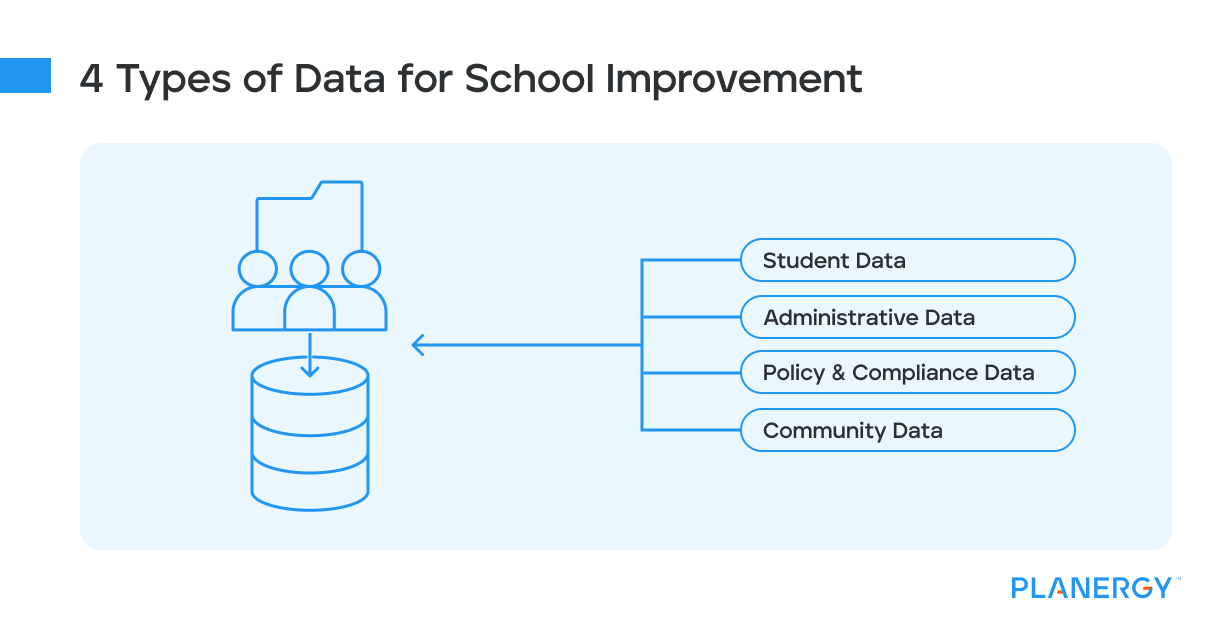
Student Data
Student data forms the foundation of effective school improvement.
This includes attendance records, grades, behavior logs, and assessments that capture learning progress.
By analyzing this data, schools can identify patterns that impact academic performance.
For example, consistent tardiness or absence might highlight external challenges a student is facing, signaling the need for additional support.
Learning assessments are another critical aspect. They provide insights into areas where students excel or struggle.
For instance, if a group of students consistently underperforms in math, schools can introduce targeted tutoring programs or adjust teaching methods.
By centralizing and managing student data, educators can make informed decisions to personalize learning paths and ensure that no student falls behind.
Administrative Data
Administrative data focuses on the operational backbone of a school.
This includes faculty performance evaluations, staff training records, payroll information, budget allocation, and facilities management.
Effective oversight of this data ensures that resources are efficiently utilized and workflows run smoothly.
For example, performance evaluations can highlight professional development needs among teachers, paving the way for training workshops or mentorship opportunities.
Payroll and budget data, on the other hand, can guide decisions such as whether to hire additional staff or invest in new educational tools.
Keeping facilities management data up to date ensures that schools prioritize maintenance in areas directly impacting the student experience, like repairing classrooms or upgrading technology.
Community Data
Community data takes into account feedback from parents, students, and staff to measure satisfaction and engagement.
This type of data emphasizes the importance of collaboration between schools and their wider community.
For example, parents might express concerns about a lack of extracurricular opportunities, while students could highlight the need for more inclusive teaching practices.
Surveys and focus groups are common ways to collect this information.
A school might use community feedback to implement initiatives such as mental health support programs or inclusive curriculum updates for children with disabilities.
Policy & Compliance Data
Schools operate within stringent legal and regulatory frameworks, making policy and compliance data a critical part of school improvement efforts.
This includes records on adherence to educational legislation, health and safety requirements, and accreditation mandates.
For example, schools need to maintain up-to-date documentation for student enrollment, standardized testing, or fire safety drills.
Bridging the Data for Holistic School Improvement
Each type of data plays a unique role in propelling schools forward.
When combined, student, administrative, community, and compliance data create a comprehensive picture of a school’s strengths and areas for development.
Key Principles of Education Data Management for Schools and Trusts
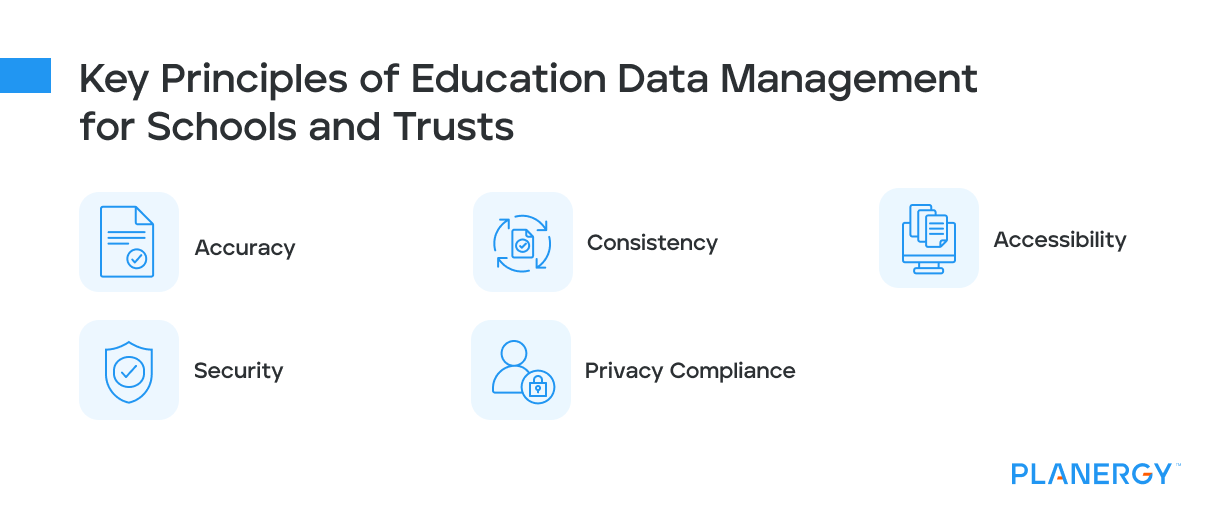
Accuracy
Accuracy is the foundation of effective educational data management.
Ensuring that all entries—attendance records, grades, or assessment results—are correct prevents costly errors in decision-making processes.
For example, a typo in a student’s attendance record could lead to a miscalculation in program funding based on attendance rates.
Similarly, incorrect test scores might wrongly classify a student as needing remedial support.
Schools can maintain accuracy by implementing clear data entry protocols, training staff on these procedures, and using automated tools to minimize human error.
Regular audits of databases can help identify and correct discrepancies early.
Consistency
Consistency in data management ensures a seamless flow of information across various systems and departments.
For example, if one department labels students as “Grade 9,” while another uses “9th Grade,” integration across platforms can create mismatches and reporting challenges.
Standardizing formats, labels, and definitions across all data sets prevents these issues.
Using a centralized data management system can enforce consistency by setting parameters that align with agreed-upon standards.
For instance, consistent formatting for date entries (e.g., MM/DD/YYYY) ensures smooth integration and interpretation of data from multiple sources.
Consistency improves the accuracy of reports, simplifies collaboration, and enhances the overall understanding of complex data points.
Security
Student records, staff payroll details, and operational data are vulnerable to unauthorized access or cyberattacks if not safeguarded adequately.
Schools can mitigate these risks by adopting security measures such as encryption, multi-factor authentication, and regular software updates.
For example, encrypting student data ensures that the information remains indecipherable even if unauthorized users gain access to a system.
Regular vulnerability assessments can identify weak points in a school’s IT infrastructure, allowing for timely interventions.
Secure systems not only protect the privacy of students and staff but also bolster trust among parents and community stakeholders.
Accessibility
Data is only useful if the right people can access it when they need it.
Teachers, administrators, and counselors depend on timely access to information to make informed decisions.
For instance, a teacher planning interventions for struggling students needs immediate access to academic performance records and behavior logs.
To ensure accessibility, schools can adopt user-friendly platforms that provide authorized users with role-based access.
This means users see only the data relevant to their responsibilities, reducing the risk of misuse or overwhelm.
Privacy Compliance
Educational institutions must adhere to data protection regulations such as FERPA (Family Educational Rights and Privacy Act) in the U.S. or GDPR (General Data Protection Regulation) in Europe.
These laws ensure the confidentiality of student and staff data, placing strict limits on its collection, storage, and sharing.
For example, under FERPA, schools need parental consent before disclosing a student’s educational records to third parties.
Ensuring privacy compliance requires clear policies on who can access specific data, how it’s shared, and where it’s stored.
Regular training for staff on data protection laws and best practices is essential.
Data privacy is not just a technological issue but a fundamental responsibility. Institutions must take a proactive approach to safeguard sensitive information, as trust and reputation are at stake.
Best Practices for Education Data Management
The following practices can help streamline education data management and improve outcomes for schools and trusts.

Centralize Data Storage
Invest in a centralized storage system to minimize duplicates and ensure consistent data quality, for a single source of truth.
Cloud-based solutions are particularly valuable for scalability and ease of access, with controlled data sharing.
Train Your Staff
Effective data management relies on staff understanding how to use data systems.
Regular training sessions empower users to maximize the value of collected data.
Implement Real-Time Data Tracking
Tools that enable live data tracking help educators and administrators respond quickly to emerging issues, such as falling grades or attendance dips.
When implemented across the board, school districts can quickly check in on current data for any school within the system.
Automate Where Possible
Invest in automated platforms to handle repetitive tasks like attendance tracking or grade recording.
This saves time for staff while improving accuracy.
Conduct Regular Audits
Schedule routine audits of your data systems to ensure compliance, detect security vulnerabilities, and identify areas for optimization.
Tools and Technologies to Streamline Data Management

Student Information Systems (SIS)
Student Information Systems, such as PowerSchool or Skyward, are crucial for managing student records efficiently.
These platforms centralize data like grades, attendance, and contact details, streamlining administrative tasks.
Data Analytics Tools
Platforms like Tableau or Microsoft Power BI empower schools to analyze data and uncover trends that inform strategic decisions.
These tools can identify performance gaps, such as declining test scores in a specific subject or increasing absenteeism in a particular grade.
They also offer easy visualization, making data analysis easier for everyone.
Learning Management Systems (LMS)
Learning Management Systems, like Moodle or Google Classroom, are essential for tracking student progress and enhancing lesson planning.
These tools allow teachers to assign tasks, grade assignments, and communicate with students—all in one platform.
Cloud Storage Solutions
Cloud storage services like Google Drive or Microsoft Azure offer secure and scalable data management solutions.
These platforms ensure that authorized users access vital information anytime, from anywhere.
Challenges of Managing Education Data in Schools
Lack of Staff Training
One of the most common barriers to successful implementation is insufficient staff training.
Teachers, administrators, and support staff often lack the technical expertise to input, analyze, and interpret data accurately.
This can lead to errors, underutilization of the system’s features, and employee frustration.
Schools and trusts should prioritize allocating resources for comprehensive staff training programs.
Training should be ongoing rather than a one-time event, ensuring that staff members remain proficient as the system evolves or is updated.
Organizations can choose from in-person workshops, online tutorials, or even hiring external providers to provide expert guidance.
Challenges in Selecting the Right Tools
Poorly chosen tools can become a financial burden and lead to inefficiencies, as they may not integrate well with existing systems or fail to provide the needed functionality.
To overcome these challenges, it is critical to assess your institution’s unique data management requirements beforehand.
Consider scalability, user-friendliness, integration capabilities, and customization options.
Opt-in for platforms with open APIs, as they offer flexibility and are more likely to adapt to the evolving demands of modern education.
Conducting a thorough review process, including demos and trials, will allow decision-makers to make informed choices while avoiding costly mistakes.
Resistance to Change
Implementing a new data management system may cause apprehension among staff members accustomed to existing workflows or unfamiliar with digital technologies.
To mitigate resistance, communicate the new system’s benefits clearly and consistently to all stakeholders.
Highlight how the system will simplify tasks, enhance efficiency, and improve student and staff outcomes.
Providing platforms for feedback, hosting Q&A sessions, and involving staff in decision-making processes can also foster buy-in and reduce hesitance.
Change management strategies, such as creating pilot programs or appointing tech-savvy “change ambassadors,” can further ease the transition.
Ensuring Data Privacy and Security
Education institutions handle sensitive information about students, families, and staff, making them a potential cyberattack target.
Data breaches can lead to legal repercussions, loss of trust, and significant financial penalties, emphasizing the need for robust security measures.
Schools and trusts should adopt proactive measures such as encryption, multi-factor authentication, and regular security audits to ensure data privacy and security.
Complying with local and international data protection regulations, such as FERPA or GDPR, is also crucial to safeguarding sensitive information.
Furthermore, staff must be educated on data security protocols, including the importance of strong passwords and recognizing phishing attempts.
Final Thoughts
Effective education data management is not just about tracking numbers—it’s about using data to create meaningful, impactful decisions for students, educators, and administrators alike.
By adhering to best practices and investing in the right tools, schools and trusts can overcome common challenges and promote a culture of continuous improvement.
